Japanese Video Games and Localization Challenges
Who hasn’t heard of Super Mario or Sony’s PlayStation consoles? None, most likely. This is how widely popular Japanese games and console makers, or the Japanese gaming culture in general, have become throughout the previous decades. “Video games would not have grown as an independent sector without Japan, and no other country has contributed to this field, from software and equipment to the dissemination of gaming culture,” said video game expert Blake J. Harris.
A worth of $20 billion is what Japan’s video game industry has reached. New Zealand Games Analytics report sheds light on the significant innovations Japanese gaming personnel have contributed to this field.
It all started with Sony’s PlayStation. The company launched the console in 1994, during the heyday of famicom, tapes, and CDs. This revolutionary invention provided the idea for bigger storage and for a lower price. Hajime Shacho proudly says, “the gaming world has been drastically changed and evolved ever since Sony decided to introduce its device. It was a step into the future of the gaming sphere dominated by the Japanese.” It is the future that we all live in now.
Two years later, Nintendo’s Super Mario 64 was introduced. The fascinating thing about this innovation is that it was called a 3D game, although 3D technology was not still alive then. During this time, the Americans represented by Microsoft and Sony started competing with each other to outrun Sega, another well-known Japanese video game company at the time.
The uniqueness of Japanese video games
Nintendo and Sony were the pioneers paving the way for Japanese gamers and developers. Their game system has profoundly impacted the world gaming culture ever since. New Zealand Games Analytics report explores the secrets behind this tremendous success. According to the article, besides the constant development of their gaming technology, these two companies remained rooted in Japanese culture and continued to incorporate that into the gaming industry.
Does Japanese culture play a role in their game development?
One must wonder how these two Japanese companies could attract gamers globally and later dominate a significant part of the video gaming world. The answer is in their culture itself. These two companies combined their passion, talent, and limited sources to create fruitful images in games such as Haiku.
The same thing was done in animation. They managed to use limited resources and objects to come up with great products creatively. That was the contrary of what Disney did. Disney used full animation while the Japanese used little graphics. Limited graphics is a technique that has been developed to use minimal resources and limited images for a story.
Japanese vs western gaming culture
Different types of games are more prevalent in Japan than in other parts of the world. An obvious one is the RPGs or JRPGs. In the past 10-15 years, they have become more prevalent in the West. However, they may not do as well as they do in Japan. This also applies to retro gaming.
Another big difference is that many RPGs in the West cost a lot. Super Nintendo RPGs like Chrono Trigger are excellent examples. Final Fantasy 3 and Earthbound are also costly games, especially if you want complete copies of them.
Handheld gaming also propelled the Japan gaming market further. Tokyo is a city built best for public transportation. Many Japanese spend thirty minutes to an hour commuting from and to work. This gives them time to fill with handheld console gaming or mobile gaming.
The last difference is that arcade gaming or rhythm games are still popular in Japan. That ties in with the fact that Japanese people are away from home a lot. There are numerous gaming centers all around Tokyo and other cities in Japan. For some people, the arcade game is a kind of social occasion. It is not just a way to kill time but rather another way to socialize and hang out with friends.
Translation & localization of Japanese games
Several gamers around the world sometimes complain about the quality of translation and localization of Japanese games, specifically the literal translations of JRPGs. The following section summarizes some insights on the topic of localization and censorship in Japan’s game industry from several Western gamers.
Japanese game localization must feel like a thankless job. So many people point out that this does not seem right or different, or even worse, they may confuse changes for censorship. Not every change is censorship. Changes are necessary when localizing. For example, there is no one-to-one translation from Japanese to English. Therefore, doing simple, literal translations without proper localization not only disrupts the developers’ intent and vision; it also blurs our understanding of the story.
Significant changes that people see in localized Japanese games are most often done with input from or with the guidance of the original developers. You might wonder why a character’s name has been changed to something that sounds nothing like the original Japanese name. Maybe the original Japanese name was common in Japan, and the developer intended that the character’s name be common, so during localization, they changed the name to a common English name.
In localization, a multitude of options are weighed, and decisions are made to deliver best a product that accurately represents the developer’s vision and intent. Sometimes, this part of the work or change is unfortunately confused with censorship. Censorship is when, for instance, developers are requested to make changes to their game prior to release, like altering lingerie outfits or other mature or violent dialogues and scenes, sometimes against the developers’ or game fans’ wishes.
Localization teams are doing their best, and without them, we would be missing so many brilliant games. Localizing is full of challenges, but when done right, they ensure the best possible representation of the original game in a way that we can completely understand and appreciate.
—
Quality game localization is a big step towards your success in the international gaming industry. Here at CCCI, we provide desktop, mobile, browser, and console games localization and customer support in 30+ languages around the US, Europe, and Asia.
Working with top Japanese game companies for over a decade has allowed us to hone our skills in game localization. Along with our manga and webtoon translation services, mobile and PC games translation has become another of our specialties in the field of translation. Due to its creative and highly niche work, it has become a service separate from our general and specialized translations.






